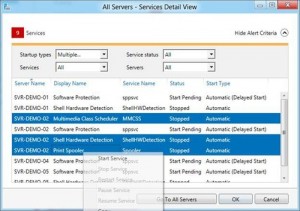 Microsoft has taken its server OS a giant step forward with yesterday’s release of Windows Server 2012, making this version the first that can be controlled remotely so it is more suitable for data centres.
Microsoft has taken its server OS a giant step forward with yesterday’s release of Windows Server 2012, making this version the first that can be controlled remotely so it is more suitable for data centres.
“Microsoft has delivered on the promise of an operating system that can be completely managed from the command line,” said Don Jones, an author of a series of Windows 2012 instructional videos that have been released by the training firm CBT Nuggets.
“The technologies are in place to manage 100 servers as easily as you can manage one server,” he added.
The first major upgrade since 2009 features a bevy of new features, most designed to make it more suitable for large-scale data-centre deployments. Satya Nadella, Microsoft president for Server and Tools, has touted this release as Microsoft’s “Cloud OS.”
Microsoft’s Hyper-V virtualisation can now support up to 64 virtual processors and 1TB of memory for guests, a marked improvement from the old limit of four virtual processors and 64GB of memory. The Server Message Block (SMB) network communication protocol has been updated to handle faster data transfers and the OS’s Server Manager has been updated to handle multiple servers at once.
But perhaps the most significant enhancement is one that may not be noticed among these flashy new features. Thanks to the inclusion of the PowerShell, first introduced six years ago, this will be the first version of Windows Server that can be completely controlled through the command line, making it controllable remotely.
PowerShell provides the Windows similar capabilities that chief competitor Unix has long offered, such as the ability to forward, or pipe, the output of one process to the input of another process. It even adds a few new tricks, such as the ability to handle software objects, which have come about from studying Unix’s limitations. “It is an incredibly well-designed shell,” Jones said.
Of course, the GUI is still available for those who require it, but “you can remove the GUI and it will be a fully functional server,” Jones said. Doing away with the need for a GUI (graphical user interface) means that servers can be managed more efficiently in multiple numbers, Jones said. “If you are still using management techniques where you are still physically touching the server, you need to move to the 21st century and managing it like a server in a data centre.”
For instance, an administrator may now have to execute a routine task on a server once a week — such as backing up data — by clicking through a series of options on a graphical program. With the command line, the administrator can write a script in PowerShell to run though all of those steps automatically and that script can run against multiple machines.
PowerShell may require some studied learning for those used to GUIs, but it is time well invested, Jones said, adding that his videos were designed to help give users an introduction to the technology. In addition to PowerShell, Windows Server 2012 also features a data-centre-friendly installation method called Server Core, which provides a way to install the OS over the network.
One hardware partner, Dell, has wasted no time in updating its line of servers to run Windows Server 2012. The company designed its PowerEdge 12th generation (12G) servers around Windows Server 2012. The new blade, rack and tower servers run Intel Xeon E5-2600 processors and feature extreme memory density, hot-swappable hard drives and solid state drives, and a range of advanced features to support networking.
Microsoft “engineered the Windows Server 2012 for the private cloud. Our part of the equation is to deliver hardware and systems that are enabled for virtualisation,” said Brian Payne, executive director of Dell PowerEdge servers. The 12G was designed to host the many multiple virtual machines that Hyper-V can host, he noted. Dell also designed software to take advantage of Windows Server 2012’s ODX (Offload Data Transfer) protocol, which allows data to be moved among different server nodes without the need of the server CPU.





